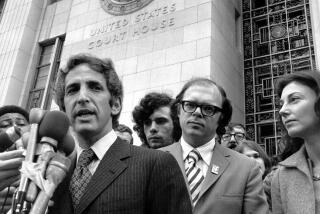Psst, Wanna Read Your FBI File? Check It Out!
- Share via
WASHINGTON — The work of two low-level gumshoes in the White House who got background files on more than 400 employees of past administrations has mushroomed into a major embarrassment for President Bill Clinton. What is still unclear is whether it was all a “bureaucratic snafu,” as the president maintains, or something more sinister, conjuring up images of President Richard M. Nixon’s enemies lists and the ghost of J. Edgar Hoover.
With all the brouhaha and congressional hearings, remarkably little is known, even inside the Beltway, about FBI files--who has one, what they contain, how they are (normally) protected, even what they look like.
Most of the files are right there in the fortress-like J. Edgar Hoover building on Pennsylvania Avenue, under lock and key. Physically, the files today have a stiff white cover, nine by 11 1/2 inches, and the secrets they hold are bound in place by ordinary metal fasteners. The files flip open at the top. Though many of the FBI’s records are computerized, the background files are not. The bureau is an old-fashioned place.
On the cover of each file are the words, “FBI HQ Investigative and Administrative Files.” A border of thick, black diagonal lines runs around the cover. Some particularly sensitive files bear a classification stamp, such as “SECRET.”
The Federal Bureau of Investigation has two main types of files. First, it has records of background investigations of applicants for employment at, or access to, the White House, and for jobs at a few federal agencies, such as the Justice Department, the FBI itself and the federal courts. Most federal agencies, including the Pentagon and the CIA, perform their own background checks. Second, the FBI has files of criminal investigations, including counterintelligence investigations of suspected terrorists or spies.
Typically, for a background investigation of a person up for a job on the White House staff, FBI special agents interview friends, neighbors and associates, and check the bureau’s own files to see if the person has a criminal record. According to FBI officials, the agents are alert, among other matters, for any contacts the person might have with foreigners, “details of applicant’s personal life that could be used to coerce the applicant,” any “psychological counseling,” “alcohol abuse, or illegal drug use,” membership in restricted organizations or “lifestyle” issues that might “compromise” them.
The files, in other words, contain gossip and raw data. The reports in the files are summarized and sent to the White House--including any derogatory information. On new investigations--but not, apparently, the old files sent to the Clinton staff--if something bad turns up, the files that go to the White House also contain the complete texts of the FBI interviews, sometimes with the source blacked out. Files, therefore, often contain unevaluated information. But the FBI insists any adverse information is checked further and “resolved whenever possible . . . to assure that the nominee’s character is not impugned by spurious information, rumor or innuendo.”
Those are precisely the morsels that were the coin of Hoover’s realm, the great source of much of his power. Hoover, who presided over the bureau for 48 years until his death in 1972, was, in the words of William C. Sullivan, one of his sycophantic subordinates and later a critic, “a master blackmailer.”
As Sullivan once explained, “The moment he would get something on a senator he’d send one of the errand boys up and advise the senator that . . . by chance [the FBI] happened to come up with this data on your daughter . . . . But don’t have any concern, no one will ever learn about it. Well, Jesus, what does that tell the senator? From that time on, the senator’s right in his pocket.”
Hoover’s name popped up often in the taped conversations that Nixon had with White House counsel John Dean during Watergate. “He has a file on everybody,” Nixon told Dean.
Indeed, the files were one reason that no president dared fire Hoover, though some would have liked to. In 1962, when the FBI chief learned that President John F. Kennedy had been consorting with Judith Campbell Exner, who was also a friend of mobsters, he could hardly wait to break the good news to the president. Hoover went to the White House with Exner’s file and had lunch with Kennedy, who cut off all contact with Exner in a phone call that afternoon.
Sullivan claimed there was a similar episode involving Nixon. In his book, “The Bureau,” Sullivan said an FBI agent in Hong Kong reported that Nixon, while a lawyer in private practice, and before he was elected president, spent time with “a Chinese girl named Marianna Liu.” It was the sort of report that made Hoover salivate.
“ ‘I’ll handle this one,’ Hoover said gleefully,” according to Sullivan. The FBI director, Sullivan said, took the report to Nixon and pledged never to speak of it. “It was one of his [Hoover’s] favorite speeches, one he gave often to politicians,” Sullivan wrote.
The bureau had other files for what, in retrospect, seem rather ominous purposes. For 31 years, beginning in 1939, the FBI maintained a Security Index containing the names of 26,000 Americans to be arrested in an emergency or in wartime--including thousands listed for “priority apprehension.” The Internal Security Act of 1950 authorized detention camps for suspected citizens. Six camps were actually built, but never used.
Hoover kept files on Hollywood stars, prominent writers, antiwar protesters, black activists and others. He even spied on the Supreme Court. Said one note in the FBI file on Justice William O. Douglas, “Douglas, of course, is crazy and is not in too good health.”
As it turns out, quite a few FBI files are not that secret, after all. In a small, windowless room at FBI headquarters there is a public reading room where visitors, by appointment, may read FBI files on individuals ranging from Marilyn Monroe to John Wayne, from Elvis to Einstein. All of these files were released under the Freedom of Information Act.
A file in the reading room on Lucille Ball, for example, says “Ball was registered as a Communist voter.” The file on Marilyn Monroe says, “Norman Mailer . . . an eccentric but well-known author” suggests in his biography of the actress that “ ‘right-wing’ FBI and CIA agents had a ‘huge motivation’ to murder Marilyn Monroe in order to embarrass the Kennedy family.” The Elvis Presley file notes that the rock star’s “gyrations” were the subject of public criticism. The singer has asked to meet Hoover. Elvis, the file says, “is certainly not the type of individual whom the Director would wish to meet. It is noted at the present time he is wearing his hair down to his shoulders and indulges in the wearing of all sorts of exotic dress.” The bureau got that right.
Among the other once-secret files available for perusal at FBI headquarters are those on Tokyo Rose, John Dillinger, Amelia Earhart, Errol Flynn, Clark Gable, Marcus Garvey, Dashiell Hammett, Rita Hayworth, Ernest Hemingway, Adolf Hitler, Alger Hiss, Janis Joplin, Lee Harvey Oswald, Liberace, Pablo Picasso--and Hoover himself.
Contrary to popular belief, most people do not have an FBI file. A shoe salesman in San Jose or a farmer in Dubuque, unless he robs a bank in his spare time, will almost certainly not have an FBI file. But anyone is entitled to see his or her own FBI file by writing to the bureau under the Freedom of Information and Privacy Acts. Be prepared for a long wait, however. At the moment, the bureau has a backlog of 15,259 requests, including some from people curious to view their own files. But as the White House has discovered, reading FBI files may not always be such a great idea.
More to Read
Get the L.A. Times Politics newsletter
Deeply reported insights into legislation, politics and policy from Sacramento, Washington and beyond. In your inbox three times per week.
You may occasionally receive promotional content from the Los Angeles Times.










